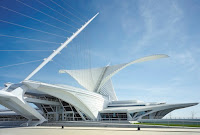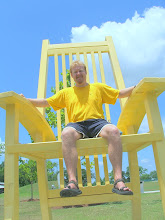Calatrava typically paints images—a leaping figure, a charging bull, a disembodied eye, a skeletal hand—that at first seem to have nothing to do with buildings but, rather, suggest the contents of the sketchbook of an art student who has spent the afternoon at MOMA lingering over the Picassos. The relevance of such drawings becomes fully apparent in Calatrava’s completed structures, which are instantly recognizable for their use of sculptural forms that draw upon motifs found in the natural world.
The Turning Torso tower, in Malmö, Sweden was inspired by Calatrava's study of the human spine.

What I found most interesting about Calatrava was his signature move of sketching in public. In her New Yorker article Mead describes how Calatrava has used this to help win important commissions.
In Liège, Belgium, Calatrava was one of seven contestants in an architectural competition to design a high-speed-train station. His rivals came in teams, armed with examples of their past work; Calatrava showed up alone, with his paintbrush, and won the commission. In January, 2004, while presenting his proposal for a new PATH transit hub for the World Trade Center site, Calatrava drew in chalk a child releasing a bird from her hands, thus conveying the genesis of the design, in which a pair of glass-and-steel canopies would arch over the sidewalks of lower Manhattan, like outstretched wings.
Read the full article describing Calatrava's life and creative process in the following New Yorker article:
http://www.newyorker.com/reporting/2008/09/01/080901fa_fact_mead





No comments:
Post a Comment